Use of Orbital LIDAR in the Brazilian Cerrado Biome: Potential Applications and Data Availability
Abstract
:1. Introduction
2. Data Analysis and Approaches
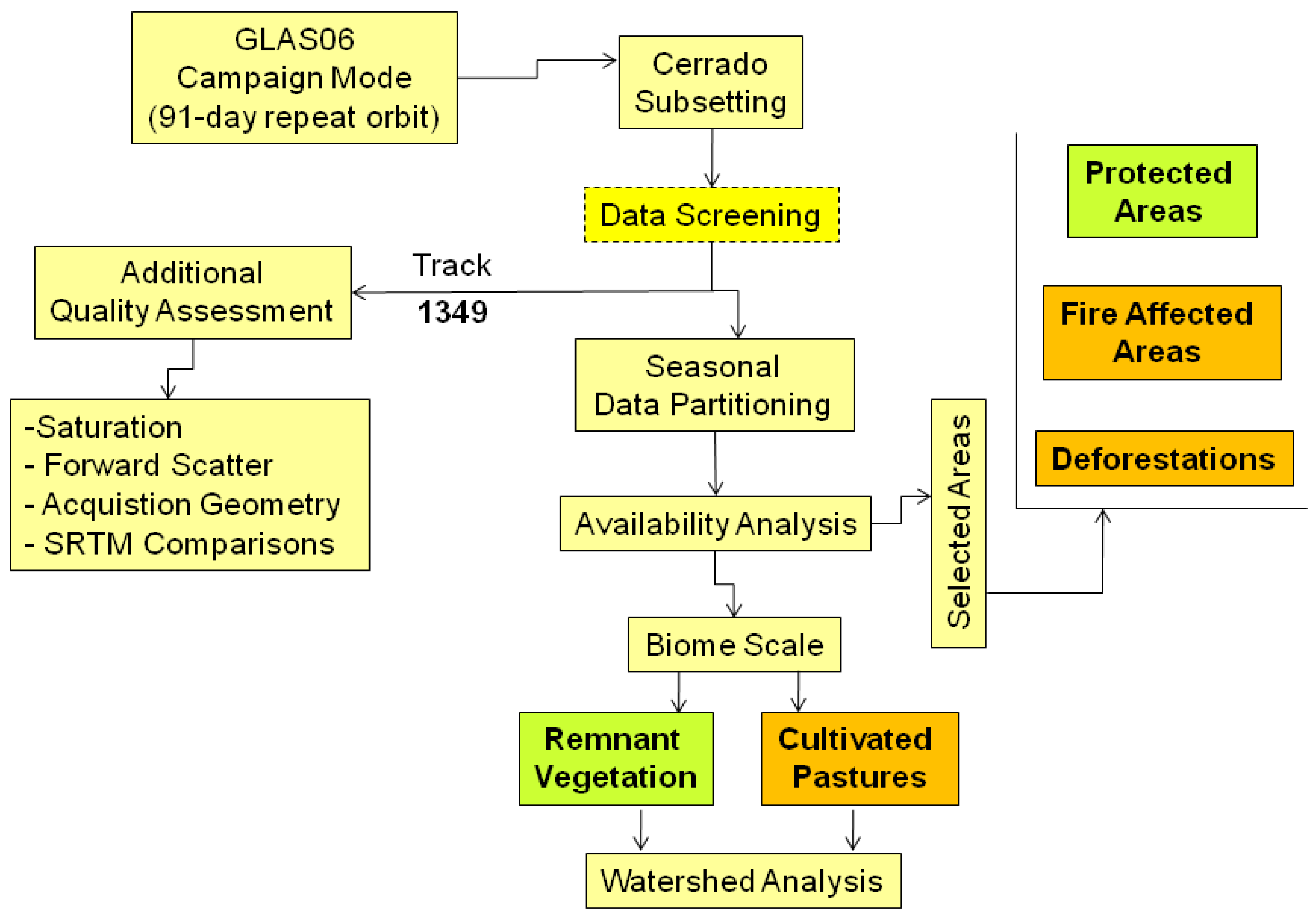
3. Results and Discussions
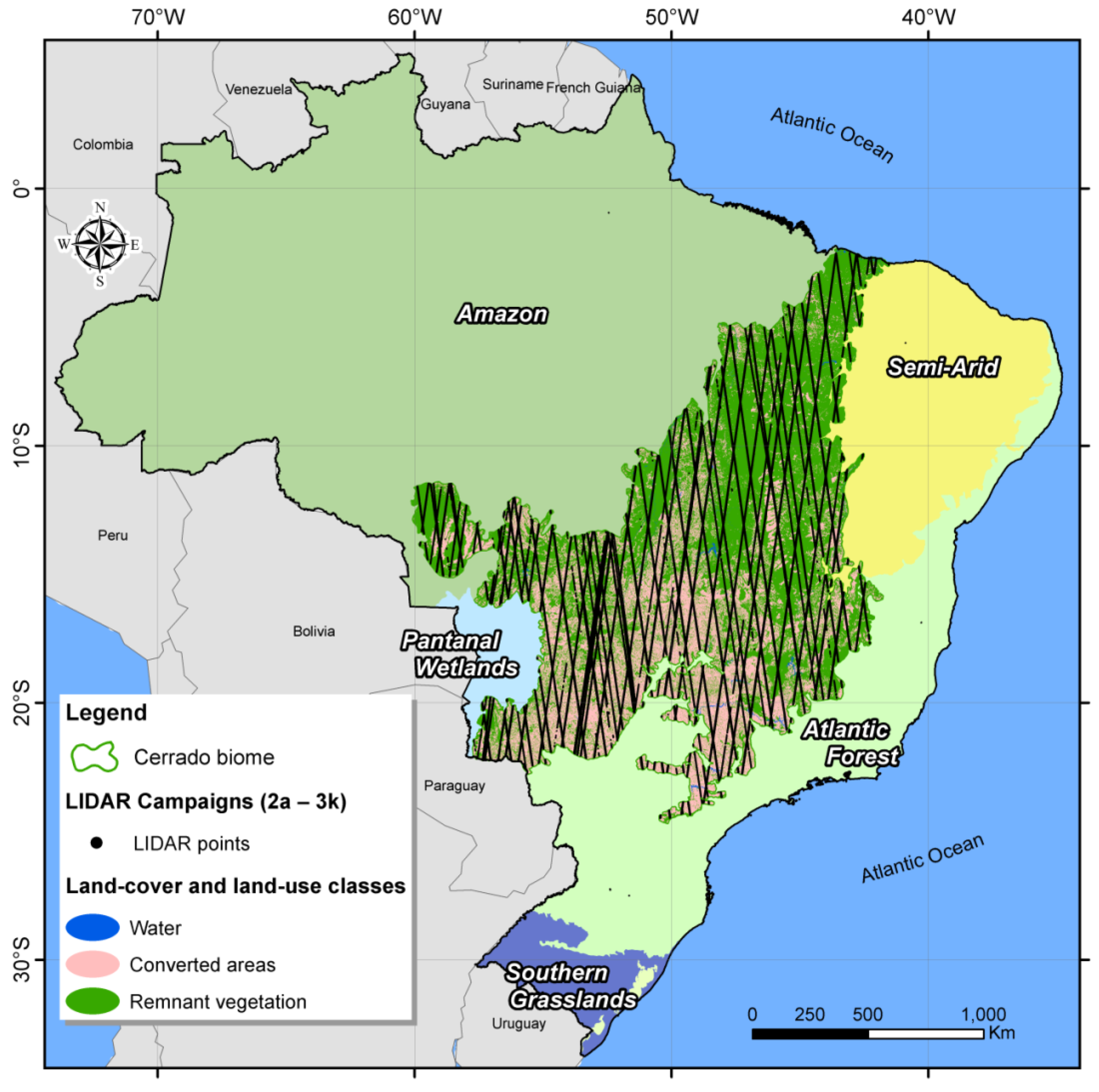
 |
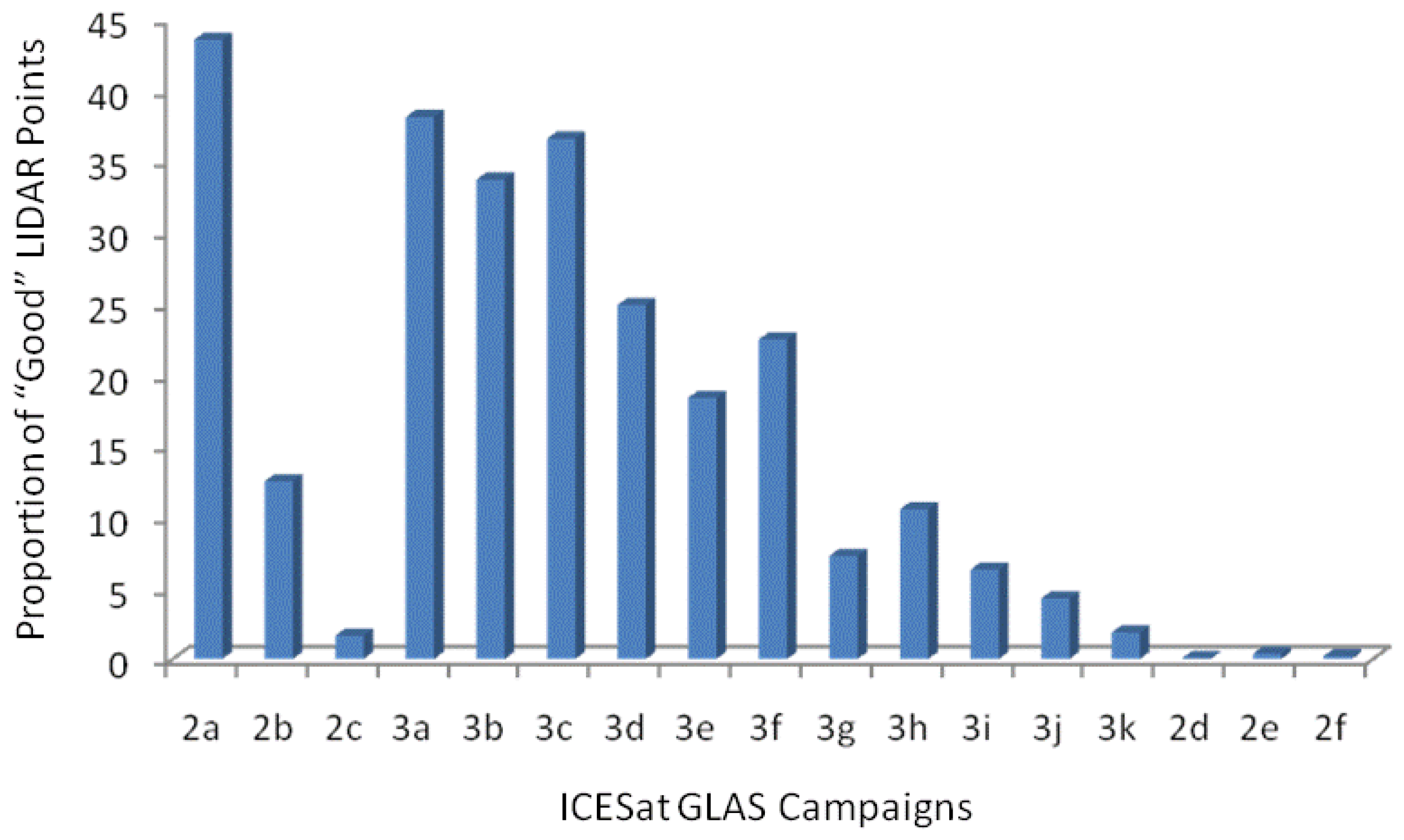
| LIDAR–SRTM Differences | ||||
|---|---|---|---|---|
| Campaigns | Differences − Latitude (r) | # LIDAR Points | Mean Values | CV |
| 2a | −0.60 | 1,817.00 | −14.75 | 0.42 |
| 2b | ||||
| 2c | −0.56 | 307.00 | −17.18 | 0.27 |
| 3a | −0.63 | 1,996.00 | −13.42 | 0.48 |
| 3b | −0.85 | 2,338.00 | −15.80 | 0.48 |
| 3c | −0.80 | 1,144.00 | −19.26 | 0.36 |
| 3d | −0.64 | 1,827.00 | −16.55 | 0.33 |
| 3e | −0.79 | 350.00 | −16.57 | 0.46 |
| 3f | −0.78 | 1,225.00 | −14.87 | 0.44 |
| 3g | −0.59 | 396.00 | −11.52 | 0.34 |
| 3h | −0.71 | 297.00 | −15.43 | 0.30 |
| 3i | −0.44 | 597.00 | −16.25 | 0.29 |
| 3j | −0.24 | 448.00 | −17.78 | 0.30 |
| 3k | −0.72 | 173.00 | −18.58 | 0.24 |
| 2d | ||||
| 2e | −0.78 | 43.00 | −26.97 | 0.19 |
| 2f | ||||
| Campaigns | Shots | % Total Good Data | % Total Data | |
|---|---|---|---|---|
| Dry Season | 2c | 3,131 | 29.7 | 1.6 |
| 3c | 86,529 | 36.6 | ||
| 3f | 57,046 | 22.5 | ||
| Early Wet Season | 2a | 93,488 | 46.9 | 43.5 |
| 2d | 41 | 0.1 | ||
| 2f | 47 | 0.2 | ||
| 3a | 69,814 | 38.1 | ||
| 3d | 43,597 | 24.9 | ||
| 3g | 10,700 | 7.2 | ||
| 3i | 12,483 | 6.3 | ||
| 3k | 1,832 | 1.9 | ||
| Late Wet Season | 2b | 17,609 | 23.5 | 12.5 |
| 2e | 273 | 0.4 | ||
| 3b | 46,943 | 33.7 | ||
| 3e | 25,845 | 18.4 | ||
| 3h | 20,688 | 10.5 | ||
| 3j | 4,681 | 4.2 | ||
| % Total “Good” Shots | 100% | |||
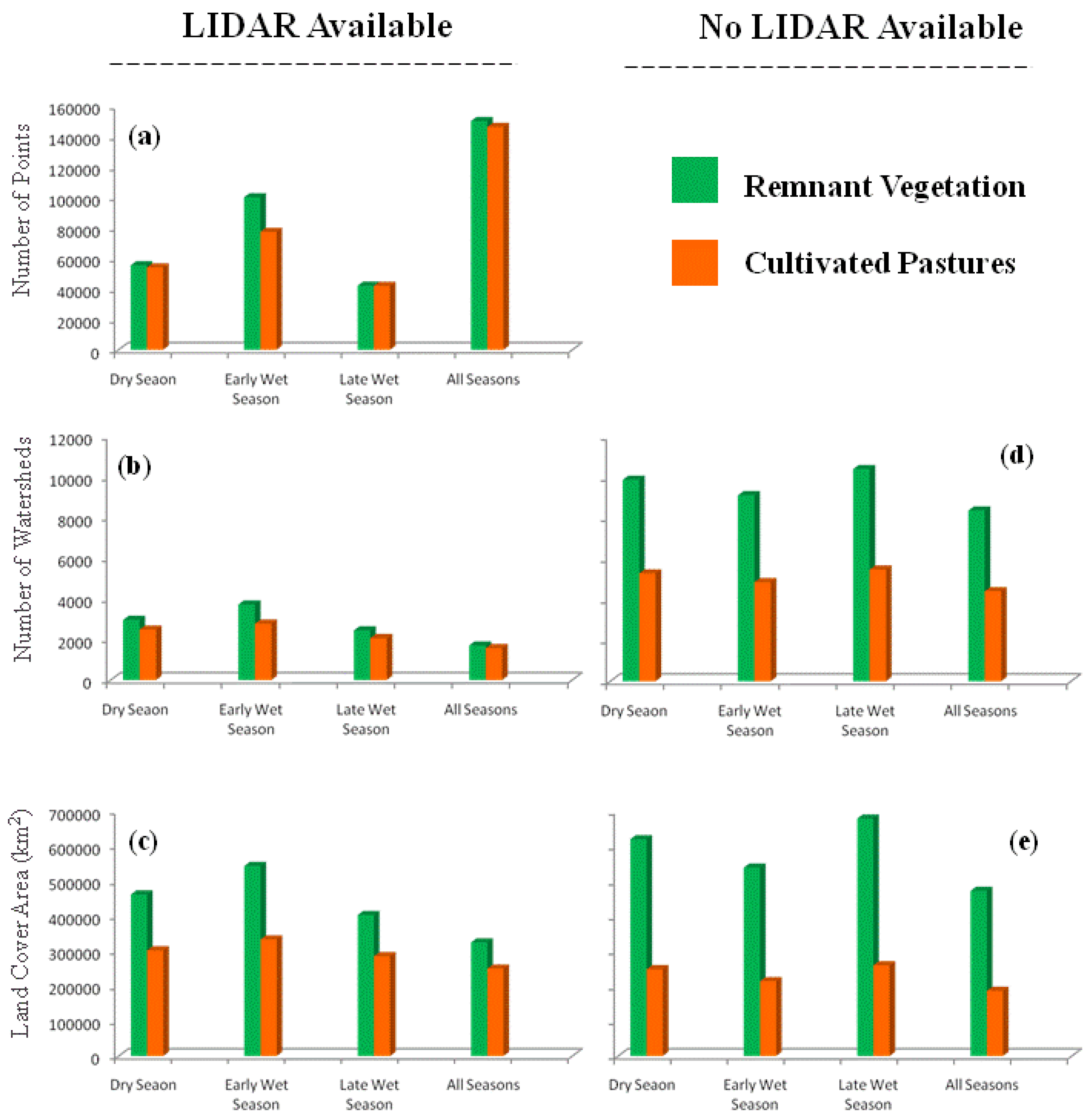
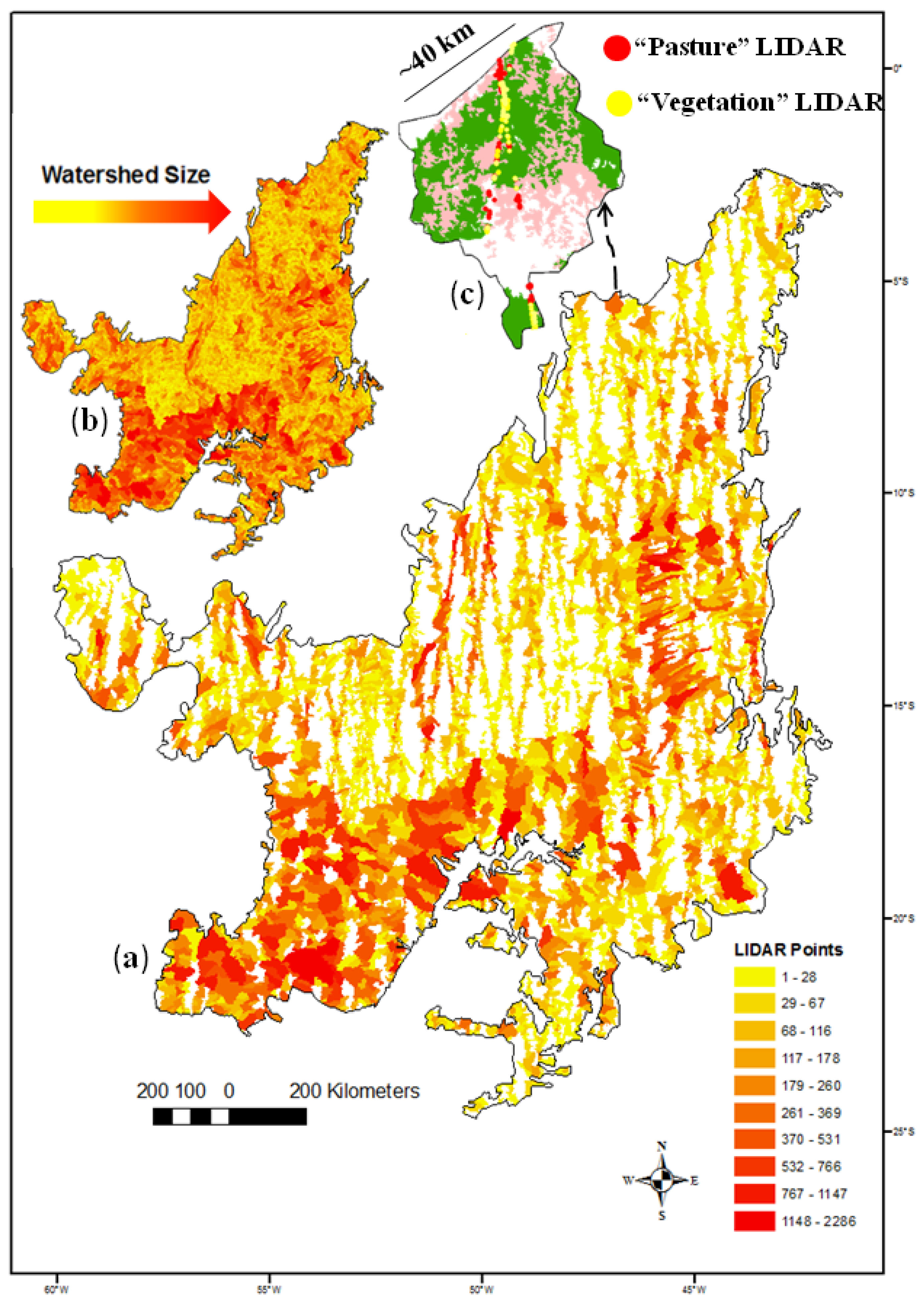

| Protected Areas | LIDAR Points | ||||||
|---|---|---|---|---|---|---|---|
| Name | State | Latitudes | Longitudes | Area (km2) | Dry | Early Wet | Late Wet |
| Veredas do Oeste Baiano Wildlife Refuge | BA | −14.061 | −45.289 | 1,280.49 | 31 | 250 | 88 |
| Águas Emendadas Ecol. Station | DF | −15.562 | −47.613 | 91.81 | 42 | 27 | 29 |
| Paraúna State Park | GO | −16.984 | −50.657 | 33.35 | 10 | 6 | 10 |
| Serra da Bocaina Wildlife Refuge | GO | −14.165 | −49.903 | 156.57 | 19 | 12 | 9 |
| Chapada das Mesas Nat. Park | MA | −7.152 | −47.145 | 1,599.52 | 142 | 60 | 59 |
| Lençóis Maranhenses Nat. Park | MA | −2.556 | −43.049 | 1,566.06 | 83 | 209 | 88 |
| Mirador State Park | MA | −6.584 | −45.282 | 4,464.47 | 477 | 578 | 46 |
| Serra da Canastra Nat. Park | MG | −20.331 | −46.585 | 1,978.11 | 4 | 33 | 6 |
| Serra Azul Biosphere Reserve | MG | −15.294 | −43.913 | 74.07 | 16 | 35 | 9 |
| Veredas do Peruaçú State Park | MG | −15.017 | −44.623 | 314.20 | 70 | 44 | 52 |
| Lapa Grande State Park | MG | −16.725 | −43.964 | 95.20 | 3 | 32 | 9 |
| Maracajú Nat. Monument | MS | −21.278 | −55.719 | 661.30 | 86 | 54 | 71 |
| Serra de Maracajú - Corguinho Nat. Mon. | MS | −19.704 | −55.279 | 365.95 | 21 | 80 | 2 |
| Iquê Ecol. Station | MT | −12.063 | −59.301 | 2,240.18 | 6 | 54 | 2 |
| Chapada dos Guimarães Nat. Park | MT | −15.324 | −55.882 | 326.56 | 26 | 70 | 5 |
| Araguaia State Park | MT | −12.280 | −50.785 | 2,258.53 | 956 | 963 | 1,274 |
| Uruçuí-Una Ecol. Station | PI | −8.869 | −45.199 | 1,386.81 | 44 | 373 | 139 |
| Nascentes do Rio Parnaíba Nat. Park | PI-MA-TO | −10.004 | −45.945 | 7,301.88 | 1,159 | 1,882 | 553 |
| Jalapão State Park | TO | −10.377 | −46.689 | 1,589.73 | 249 | 7 | 107 |
| Araguaia Nat. Park | TO | −10.554 | −50.170 | 5,665.91 | 74 | 438 | 158 |
| Cantão State Park | TO | −9.644 | −50.069 | 900.20 | 28 | 20 | 146 |
| Serra Geral do Tocantins Ecol. Station | TO-BA | −10.856 | −46.691 | 7,183.90 | 1,151 | 860 | 1,060 |
| Totals | |||||||
| % (130 Protected Areas) | 99.1 | 86.5 | 98.2 | ||||
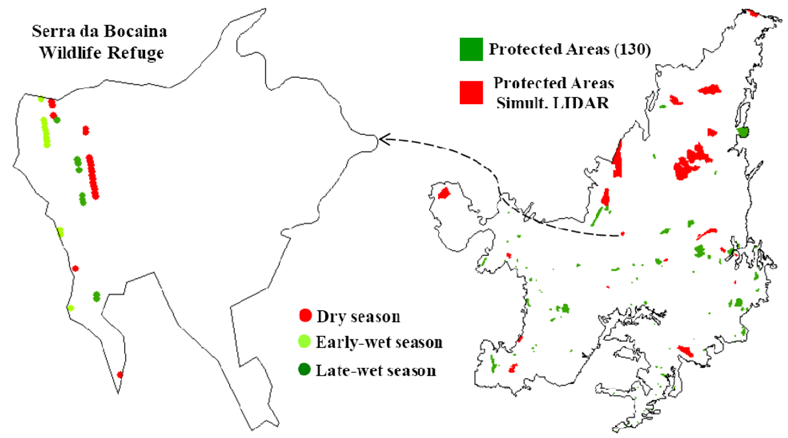 | |||||||
| Deforestation Polygons | LIDAR Points | ||||
|---|---|---|---|---|---|
| # | Area (km2) | Year | Campaign | Year | Campaign |
| 2005 | 3c | 2006 | 3f | ||
| 16 | 59.4 | 75 | 64 | ||
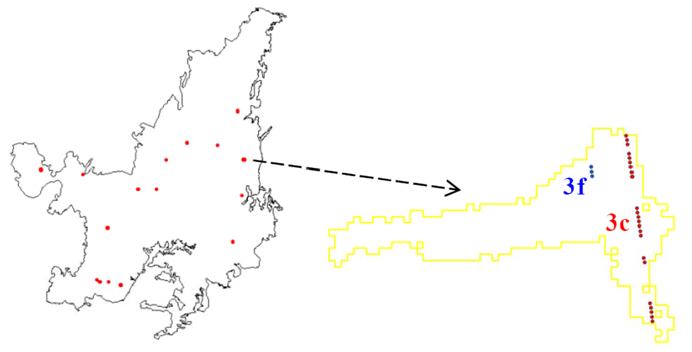 | |||||
| Time of the Year | LIDAR | Burnt Scar Polygons | 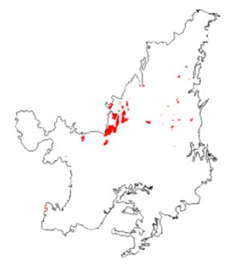 | ||
|---|---|---|---|---|---|
| Before | After | # | Area | ||
| Early wet | 488 | 16 | 10 | 1,127.5 | |
| Late wet | 1,734 | 322 | 36 | 9,245.4 | |
| During | 44 | 667 | 18 | 7,063.6 | |
4. Concluding Remarks
Acknowledgments
References
- IBGE. Mapas interativos (Mapa de Biomas); 2004. Available online: http://www.ibge.gov.br/mapas/ (accessed on 25 April 2011).
- Myers, N.; Mittermeier, R.A.; Mittermeier, C.G.; Fonseca, G.A.B.; Kent, J. Biodiversity hotspots for conservation priorities. Nature 2000, 403, 853–858. [Google Scholar] [CrossRef] [PubMed]
- Klink, C.A.; Machado, R.B. Conservation of the Brazilian Cerrado. Conserv. Biol. 2005, 19, 707–713. [Google Scholar] [CrossRef]
- Sano, E.E.; Rosa, R.; Brito, J.L.S.; Ferreira, L.G. Land cover mapping of the tropical savanna region in Brazil. Environ. Monit. Assess. 2010, 166, 113–124. [Google Scholar] [CrossRef] [PubMed]
- Brannstrom, C.; Jepson, W.; Filippi, A.M.; Redo, D.; Xu, Z.; Ganesh, S. Land change in the Brazilian Savanna (Cerrado), 1986–2002: Comparative analysis and implications for land-use policy. Land Use Policy 2008, 25, 579–595. [Google Scholar]
- Carvalho, F.M.V.; Marco, P.; Ferreira, L.G. The Cerrado into-pieces: Habitat fragmentation as a function of landscape use in the savannas of Central Brazil. Biol. Conserv. 2009, 142, 1392–1403. [Google Scholar]
- Latrubesse, E.; Amsler, M.; Morais, R.; Aquino, S. The Geomorphologic response of a large pristine alluvial river to tremendous deforestation in the South American tropics: The case of the Araguaia River. Geomorphology 2009, 113, 239–252. [Google Scholar]
- Miziara, F.; Ferreira, N.C. Expansão da fronteira agrícola e evolução da ocupação e uso do espaço no Estado de Goiás: Subsídios à política ambiental. In A encruzilhada socioambiental: biodiversidade, economia e sustentabilidade no cerrado; Ferreira, L.G., Ed.; Editora Universidade Federal de Goiás: Goiania, Brazil, 2008; pp. 107–125. [Google Scholar]
- Jepson, W.; Brannstrom, C.; Filippi, A. Access regimes and regional land change in the Brazilian Cerrado, 1972–2002. Ann. Assoc. Amer. Geogr. 2010, 100, 87–111. [Google Scholar]
- Jepson, W. A disappearing biome? Reconsidering land cover change in the Brazilian savanna. Geogr. J. 2005, 17, 99–111. [Google Scholar] [CrossRef]
- Sano, E.E.; Barcellos, A.O.; Bezerra, H.S. Assessing the spatial distribution of cultivated pastures in the Brazilian savanna. Pasturas Tropicales 2000, 22, 2–15. [Google Scholar]
- Costa, M.H.; Botta, A.; Cardille, J.A. Effects of large-scale changes in land cover on the discharge of the Tocantins River, Southeastern Amazonia. J. Hydrol. 2003, 283, 206–217. [Google Scholar]
- Costa, M.H.; Pires, G.F. Effects of amazon and central Brazil deforestation scenarios on the duration of the dry season in the arc of deforestation. Int. J. Climatol. 2010, 30, 1970–1979. [Google Scholar] [CrossRef]
- Coe, M.T.; Latrubesse, E.M.; Ferreira, M.E.; Amsler, M.L. The effects of deforestation and climate variability on the streamflow of the Araguaia River, Brazil. Biogeochemistry 2011. [Google Scholar] [CrossRef]
- Loarie, S.R.; Lobell, D.B.; Asner, G.P.; Mu, Q.; Field, C.B. Direct impacts on local climate of sugar-cane expansion in Brazil. Nature Climate Change 2011. [Google Scholar] [CrossRef]
- Potter, C.; Klooster, S.; Huete, A.R.; Genovese, V.; Bustamante, M.C.; Ferreira, L.G.; Oliveira, R.C., Jr.; Zepp, R. Terrestrial carbon sinks in the Brazilian Amazon and Cerrado Region predicted from MODIS Satellite Data and ecosystem modeling. Biogeosci. Discuss. 2009, 6, 1–23. [Google Scholar]
- Bustamante, M.M.C.; Nobre, C.A.; Smeraldi, R.; Aguiar, A.P.D.; Barioni, L.G.; Ferreira, L.G.; Longo, K.; May, P.; Ometto, J.P.H.; Pinto, A.S. Estimating recent greenhouse gas emissions from cattle raising in Brazil. Climatic Change 2010. in review. [Google Scholar]
- Houghton, R.A.; Skole, D.L.; Nobre, C.A.; Hackler, J.L.; Lawrence, K.T.; Chomentowski, W.H. Annual fluxes of carbon from deforestation and regrowth in the Brazilian Amazon. Nature 2000, 403, 301–304. [Google Scholar] [CrossRef] [PubMed]
- DeFries, R.S.; Houghton, R.A.; Hansen, M.C.; Field, C.B.; Skole, D.; Townshend, J. Carbon emissions from tropical deforestation and regrowth based on satellite observations for the 1980s and 1990s. Proc. Nat. Acad. Sci. 2002, 99, 14256–14261. [Google Scholar] [CrossRef] [PubMed]
- Achard, F.; Eva, H.D.; Mayaux, P.; Stibig, H.J.; Belward, A. Improved estimates of net carbon emissions from land cover change in the tropics for the 1990s. Glob. Biogeochem. Cycles 2004, 18. [Google Scholar] [CrossRef]
- Bustamante, M.; Ferreira, L.G. Land use change and the carbon budget in the Brazilian Cerrado. In Ecosystem Function in Savannas: Measurement and Modeling at Landscape to Global Scales; Hill, M.J., Niall, P., Hanan, N.P., Eds.; CRC Press: Boca Raton, FL, USA, 2010; pp. 367–382. [Google Scholar]
- Ferreira, L.G.; Yoshioka, H.; Huete, A.R.; Sano, E.E. Seasonal landscape and spectral vegetation index dynamics in the Brazilian Cerrado: An analysis within the Large-Scale Biosphere-Atmosphere Experiment in Amazonia (LBA). Remote Sens. Environ. 2003, 87, 534–550. [Google Scholar] [CrossRef]
- Ferreira, L.G.; Huete, A.R. Assessing the seasonal dynamics of the Brazilian Cerrado vegetation through the use of spectral vegetation indices. Int. J. Remote Sens. 2004, 25, 1837–1860. [Google Scholar] [CrossRef]
- Ferreira, M.E.; Ferreira, L.G.; Huete, A.R.; Peccinini, A.A. Análise comparativa dos produtos MODIS Ecologia para o monitoramento biofisico-ambiental do bioma Cerrado. Revista Brasileira de Geofísica 2006, 24, 251–260. [Google Scholar] [CrossRef]
- Ferreira, L.G.; Asner, G.P.; Knapp, D.E.; Davidson, E.A.; Coe, M.T.; Bustamante, M.; Oliveira, E.L. Equivalent water thickness in savanna ecosystems: MODIS estimates based on ground and EO-1 Hyperion data. Int. J. Remote Sens. 2011. [Google Scholar] [CrossRef]
- Ratana, P.; Huete, A.R.; Ferreira, L.G. Analysis of Cerrado physiognomies and conversion in the MODIS seasonal–temporal domain (LBA special issue). Earth Int. 2005, 9, 1–22. [Google Scholar] [CrossRef]
- Ferreira, M.E.; Ferreira, L.G.; Sano, E.E.; Shimabukuro, Y.E. Spectral linear mixture modelling approaches for land cover mapping of tropical savanna areas in Brazil. Int. J. Remote Sens. 2007, 28, 413–429. [Google Scholar] [CrossRef]
- Ferreira, N.C.; Ferreira, L.G.; Huete, A.R.; Ferreira, M.E. An operational deforestation mapping system using MODIS data and spatial context analysis. Int. J. Remote Sens. 2007, 28, 47–62. [Google Scholar] [CrossRef]
- Ferreira, L.G.; Ferreira, M.E.; Rocha, G.F.; Nemayer, M.; Ferreira, N.C. Dinâmica agrícola e desmatamentos em áreas de cerrado: uma análise a partir de dados censitários e imagens de resolução moderada. Revista Brasileira de Cartografia 2009, 61, 117–127. [Google Scholar]
- Rocha, G.G.; Ferreira, L.G.; Ferreira, N.C.; Ferreira, M.E. Detecção de desmatamentos no bioma Cerrado entre 2002 e 2009: Padrões, tendências e impactos. Revista Brasileira de Cartografia 2002, in press. [Google Scholar]
- Palace, M.; Keller, M.; Asner, G.P.; Hagen, S.; Braswell, B. Amazon forest structure from IKONOS satellite data and the automated characterization of forest canopy properties. Biotropica 2008, 40, 141–150. [Google Scholar] [CrossRef]
- Lucas, R.M.; Milne, A.K.; Cronin, N.; Witte, C.; Denham, R. The potential of synthetic aperture radar (SAR) for quantifying the biomass of Australia’s woodlands. Rangeland J. 2000 2000, 22, 124–140. [Google Scholar] [CrossRef]
- Santos, J.R.; Lacruz, M.S.; Araujo, L.S.; Keil, M. Savanna and tropical rainforest biomass estimation and spatialization using JERS-1 data. Int. J. Remote Sens. 2002, 23, 1217–1229. [Google Scholar] [CrossRef]
- Sano, E.E.; Ferreira, L.G.; Huete, A.R. Synthetic aperture radar (L band) and optical vegetation indices for discriminating the Brazilian savanna physiognomies: A comparative analysis. Earth Int. 2005, 9, 1–15. [Google Scholar] [CrossRef]
- Saatchi, S.S.; Houghton, R.A.; Alvala, R.C.S.; Soares, J.V.; Yu, Y. Distribution of aboveground live biomass in the Amazon basin. Global Change Biol. 2007, 13, 816–837. [Google Scholar] [CrossRef]
- Ribeiro, J.F.; Walter, B.M.T. Fitofisionomias do bioma Cerrado. In Cerrado: Ambiente e flora; Sano, S.M., Almeida, S.P., Eds.; Embrapa-CPAC: Planaltina, DF, Brazil, 1998; pp. 89–166. [Google Scholar]
- Neuenschwander, A.L.; Urban, T.J.; Gutierrez, R.; Schutz, B.E. Characterization of ICESat/GLAS waveforms over terrestrial ecosystems: Implications for vegetation mapping. J. Geophys. Res. 2008, 113. [Google Scholar] [CrossRef]
- Lefsky, M.A.; Cohen, W.B.; Acker, S.A.; Parker, G.G.; Spies, T.A.; Harding, D. Lidar remote sensing of the canopy structure and biophysical properties of Douglas-fir western hemlock forests. Remote Sens. Environ. 1999, 70, 339–361. [Google Scholar] [CrossRef]
- Lefsky, M.A.; Cohen, W.B.; Hardings, D.J.; Parke, G.G.; Ackery, S.A.; Gower, S.T. Global Lidar remote sensing of above-ground biomass in three biomes. Ecol. Biogeogr. 2002, 11, 393–400. [Google Scholar] [CrossRef]
- Helmer, E.H.; Lefsky, M.A.; Roberts, D.A. Biomass accumulation rates of Amazonian secondary forest and biomass of old-growth forests from Landsat time series and the Geoscience Laser Altimeter System. J. Appl. Remote Sens. 2009, 3, 033505. [Google Scholar]
- Chen, Q. Retrieving vegetation height of forests and woodlands over mountainous areas in the Pacific Coast region using satellite laser altimetry. Remote Sens. Environ. 2010, 114, 1610–1627. [Google Scholar] [CrossRef]
- Lee, S.; Ni-Meister, W.; Yang, W.; Chen, Q.; Hollinger, D.; Swatantran, A. Physically based vertical vegetation structure retrieval from ICESat data: Validation using LVIS in White Mountain National Forest, New Hampshire, USA. Remote Sens. Environ. 2011. accepted. [Google Scholar] [CrossRef]
- Schutz, B.E.; Zwally, H.J.; Shuman, C.A.; Hancock, D.; DiMarzio, J.P. Overview of the ICESat mission. Geophys. Res. Lett. 2005, 32, L21S01. [Google Scholar] [CrossRef]
- Baccini, A.; Laporte, N.; Goetz, S.J.; Sun, M.; Dong, H. A first map of tropical Africa’s above-ground biomass derived from satellite imagery. Environ. Res. Lett. 2008, 3. [Google Scholar] [CrossRef]
- Lefsky, M. A global forest canopy height map from the Moderate Resolution Imaging Spectroradiometer and the Geoscience Laser Altimeter System. Geophys. Res. Lett. 2010, 37, L15401. [Google Scholar] [CrossRef]
- Morisette, J.T.; Richardson, A.D.; Knapp, A.K.; Fisher, J.I.; Graham, E.A.; Abatzoglou, J.; Wilson, B.E.; Breshears, D.D.; Henebry, G.M.; Hanes, J.M.; Liang, L. Tracking the rhythm of the seasons in the face of global change: Phonological research in the 21st century. Front. Ecol. Environ. 2009, 7, 253–260. [Google Scholar] [CrossRef]
- Angelo, J.J.; Duncan, B.W.; Weishampel, J.F. Using Lidar-derived vegetation profiles to predict time since fire in an oak scrub landscape in East-Central Florida. Remote Sens. 2010, 2, 514–525. [Google Scholar] [CrossRef]
- Oliveira, O.C.; Oliveira, I.P.; Alves, B.J.R.; Urquiaga, S.; Boddey, R.M. Chemical and biological indicators of decline/degradation of Brachiaria pastures in the Brazilian Cerrado. Agric. Ecosyst. Environ. 2004, 103, 289–300. [Google Scholar] [CrossRef]
- Chien, P. Endeavour maps the world in three dimensions. Geoworld 2000, 37, 32–38. [Google Scholar]
- Berry, P.A.M.; Garlick, J.D.; Smith, R.G. Near-global validation of the SRTM DEM using satellite radar altimetry. Remote Sens. Environ. 2007, 106, 17–27. [Google Scholar] [CrossRef]
- Ministry of the Environment (MMA). Conservation and Sustainable Use of the Brazilian Biodiversity Programme (PROBIO); 2007. Available online: http://mapas.mma.gov.br/ (accessed on 25 March 2011).
- Galvão, W.S; Meneses, P.R. Avaliação dos sistemas de classificação e codificação das bacias hidrográficas brasileiras para fins de planejamento de redes hidrométricas. In Anais do Simpósio Brasileiro de Sensoriamento Remoto (SBSR), Goiania, Brazil, 16–21 April 2005; Volume 12, pp. 2511–2518.
- Agência Nacional de Águas (Brasil). Topologia hídrica: método de construção e modelagem da base hidrográfica para suporte à gestão de recursos hídricos: versão 1.11; Superintendência de Gestão da Informação, Agência Nacional de Águas: Brasília, Brazil, 2006; p. 29. [Google Scholar]
- Huete, A.R.; Didan, K.; Miura, T.; Rodriguez, E.; Gao, X.; Ferreira, L.G. Overview of the radiometric and biophysical performance of the MODIS vegetation indices. Remote Sens. Environ. 2002, 83, 195–213. [Google Scholar] [CrossRef]
- Roy, D.P.; Jin, Y.; Lewis, P.E.; Justice, C.O. Prototyping a global algorithm for systematic fire affected area mapping using MODIS time series data. Remote Sens. Environ. 2005, 97, 137–162. [Google Scholar] [CrossRef]
- Boschetti, L.; Brivio, P.A.; Eva, H.D.; Gallego, J.; Baraldi, A.; Grégoire, J.-M. A sampling method for the retrospective validation of global burned area products. IEEE Trans. Geosci. Remote Sens. 2006, 44, 1765–1774. [Google Scholar] [CrossRef]
- Boschetti, L.; Roy, D.; Hoffmann, A.A. MODIS Collection 5 Burned Area Product: MCD45 User’s Guide, Version 2.0; 2009. Available online: http://modis-fire.umd.edu/Documents/MODIS_Burned_Area_User_Guide_2.0.pdf (accessed on 1 March 2011).
- Sano, E.E.; Ferreira, L.G.; Asner, G.P.; Steinke, E.T. Spatial and temporal probabilities of obtaining cloud-free Landsat images over the Brazilian tropical savanna. Int. J. Remote Sens. 2007, 28, 2739–2752. [Google Scholar] [CrossRef]
- Gunter, B.; Urban, T.J.; Riva, R.; Helsen, M.; Harpold, R.; Poole, S.; Nagel, P.; Schutz, B.E.; Tapley, B. A comparison of coincident GRACE and ICESat data over Antarctica. J. Geod. 2009, 83, 1051–1060. [Google Scholar] [CrossRef]
- Urban, T.J.; Schutz, B.E. ICESat sea level comparisons. Geophys. Res. Lett. 2005, 32, L23S10. [Google Scholar] [CrossRef]
- Abshire, J.B.; Sun, X.; Riris, H.; Sirota, J.M.; McGarry, J.F.; Palm, S.; Yi, D.; Liiva, P. Geoscience Laser Altimeter System (GLAS) on the ICESat Mission: On-orbit measurement performance. Geophys. Res. Lett. 2005, 32, L21S02. [Google Scholar] [CrossRef]
- Abdalati, W.; Zwally, H.J.; Bindschadler, R.; Csatho, B.; Farrell, S.L.; Fricker, H.A.; Harding, D.; Kwok, R.; Lefsky, M.; Markus, T.; Marshak, A.; Neumann, T.; Palm, S.; Schutz, B.; Smith, B.; Spinhirne, J.; Webb, C. The ICESat-2 laser altimetry mission. Proc. IEEE 2010, 98, 735–751. [Google Scholar] [CrossRef]
© 2011 by the authors; licensee MDPI, Basel, Switzerland. This article is an open access article distributed under the terms and conditions of the Creative Commons Attribution license (http://creativecommons.org/licenses/by/3.0/).
Share and Cite
Ferreira, L.G.; Urban, T.J.; Neuenschawander, A.; De Araújo, F.M. Use of Orbital LIDAR in the Brazilian Cerrado Biome: Potential Applications and Data Availability. Remote Sens. 2011, 3, 2187-2206. https://doi.org/10.3390/rs3102187
Ferreira LG, Urban TJ, Neuenschawander A, De Araújo FM. Use of Orbital LIDAR in the Brazilian Cerrado Biome: Potential Applications and Data Availability. Remote Sensing. 2011; 3(10):2187-2206. https://doi.org/10.3390/rs3102187
Chicago/Turabian StyleFerreira, Laerte Guimarães, Timothy J. Urban, Amy Neuenschawander, and Fernando Moreira De Araújo. 2011. "Use of Orbital LIDAR in the Brazilian Cerrado Biome: Potential Applications and Data Availability" Remote Sensing 3, no. 10: 2187-2206. https://doi.org/10.3390/rs3102187
APA StyleFerreira, L. G., Urban, T. J., Neuenschawander, A., & De Araújo, F. M. (2011). Use of Orbital LIDAR in the Brazilian Cerrado Biome: Potential Applications and Data Availability. Remote Sensing, 3(10), 2187-2206. https://doi.org/10.3390/rs3102187




